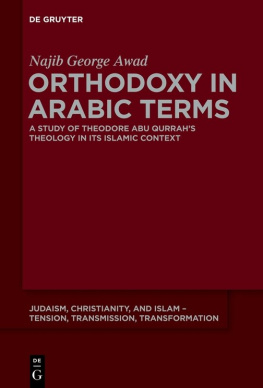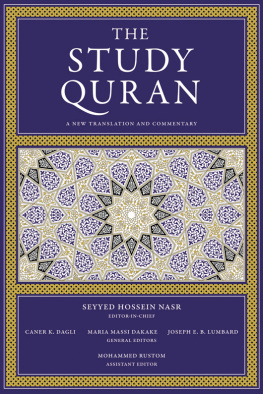PREFACE
SCOPE AND ORIENTATION
Islamic Theological Themes: A Primary Source Reader has five specific purposes. First, it offers a wide variety of primary sources as introductions to Islamic religious texts as well as Islamic theology and relational/comparative theology, especially for students who have some familiarity with the Islamic tradition and for readers with special interest in Islamic thought. Second, it broadens conceptions of Islamic theological literature beyond the confines of traditional philosophical theology ( kalm ), locating the latter within a spectrum of literature: kalm is thus presented as a particular method within the larger field of inquiry called theology. Third, it foregrounds the theological implications of a broad range of textual sources, from pretheological material on the scriptural-exegetical end of the spectrum, to the more practical and humanistic material at the other. Fourth, the collection exemplifies a rich diversity of views on a wide spectrum of topics, questions, themes, and contested issues, underscoring the problem so often posed by attempts to make sweeping generalizations about what Muslims believe. Finally, it situates Islamic theological literature within the context of the emerging subdiscipline of relational/comparative theology. Some texts included here are new translations of works, either never before translated into English or available only in now-antiquated or less than reliable versions; some reprint existing translations never before widely available; all are freshly situated and introduced with a view to opening doors into the larger world of Islamic life, belief, and culture.
STRUCTURE AND CONTENTS
Islamic Theological Themes: A Primary Source Reader organizes the material into five major parts according to genre and theme. Text selection resulted from a number of considerations. First, I wanted to provide examples across a broad chronological and geographic spectrum, with attention to as many major figures, schools, literary genres, and theological themes as possible in a single volume. Second, a broad search gathered prospective texts already available in reliable translations, but published in older or less accessible journals or in anthologies of a much broader purview and not suitable for use in courses dedicated to theological themes. Third, in view of the resulting underrepresentation of major figures, schools, or crucial themes, I solicited previously unpublished translations from scholars specializing in those topics, or I contributed my own renderings.
Selection of materialgiven size limitations, availability and cost of texts previously published, and a host of other practical considerationshas required a number of difficult editorial choices. Paramount in determining the ultimate arrangement and contents has been the concern to provide as broadly representative a selection as possible, including some less celebrated, as well as better-known, figures, works, and schools across a broad chronological and geographic spectrum. The overall genre/theme arrangement is designed to facilitate maximum pedagogical utility. Some overlap from one organizational segment to another is naturally unavoidable.
I have adopted an overall organizational structure based on an adaptation of five traditional Islamic intellectual disciplines or sciences ( ulm, plural of ilm, knowledge): the science of interpretation ( tafsr ), the science of history ( tarkh )which I call here the science of communitythe science of divine unity ( tawd ), the science of hearts ( qulb ), and the science of character ( akhlq ). (Readers interested in making cross-traditional connections with Christian theology that build on this kind of structural approach might want to look, for example, at Bernard Lonergan, SJs eight functional specializations in Method in Theology, University of Toronto Press, 1971.) A general developmental principle assumes the priority of selected foundational themes in scripture and tradition (Qurn and Hadith) and interpretation thereof (part 1). Part 2 moves to genres designed to delineate divergent views both within and beyond early Muslim communities, including perceptions of pre- and non-Islamic traditions as well as intra-Islamic articulations of the faith. Relevant material here includes heresiography, creedal formulations, and polemic. In part 3, the focus shifts to texts dealing with principles, methodologies, and foundational themes associated with various schools of systematic theology. Diverse theological dimensions associated with spirituality and communicated through several literary genres occupy part 4. Finally, theoretical and functional aspects of theological ethics form the substance of part 5.
A note on optimal pedagogical utility of the text: Differing approaches might occasionally suggest reordering chapters or even whole parts. For example, though scriptural (Qurn) and traditional texts (Hadith) and exegesis thereof are situated first, some might want to have students read chapters 3 and 4 first and then return to the foundational texts after providing some specific context in advance.
STYLE AND PRESENTATION
















